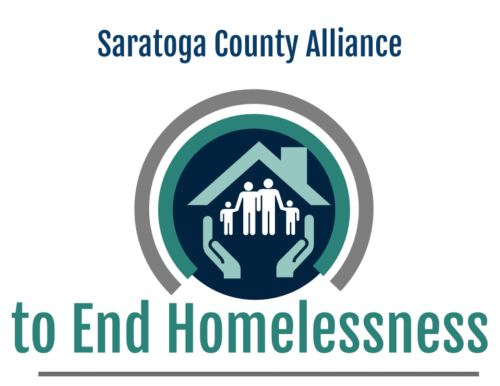
The Saratoga County Alliance to End Homelessness contributed this article that was posted in the Saratoga Today, Saratoga County Street Outreach Model Guides Homelessness Effort

We are all guilty of compassion fatigue and frustration at times. Witnessing a persistent community problem —or need— depending on your vantage point, with little insight into the solution can exhaust even the most empathetic. This exhaustion can lead to disengagement or taking on the issue ourselves without the structural knowledge to properly drive real change. Here in Saratoga, many see a growing “problem” with street homelessness and ask what exactly is being done to help these neighbors in need while also driving sustainable outcomes.
Thankfully, in Saratoga County, we have an inter-agency street outreach team funded by COVID-19 CARES Act funding set to drive real change. The Saratoga County Alliance to End Homelessness brings together five agencies tasked with achieving aggressive street outreach goals and outcomes.
Not just a hand-out: from the street to independence, CARES Act funding for the Saratoga County Street Outreach program began in fall 2020. In December, “Marc,” a local teenager experiencing homelessness, was connected to the Healing Springs street outreach team by local police officers after surviving an overdose. Having already started weekly collaborative meetings with the other four Street Outreach Program partners, team members from Healing Springs quickly identified that Marc did not have substance use issues but rather needed mental health support. An informed hand-off to CAPTAIN Community Human Services (CHS), connection to DSS services, and ultimate placement with Shelters of Saratoga (SOS) meant that Marc got connected to the right support services at the right time without having to tell his story over and over again.
Working with SOS case management, Marc is now employed, pursuing his GED, and eligible for rapid-rehousing (another component of the CARES Act program) as soon as he is stable enough to transition. “Each week, we go over 30+ cases together at our inter-agency meetings. This funding has created a level of collaboration we’d not seen before. All five agencies have now increased our referral capacity and understanding of services between agencies. For clients like Marc, it’s a game-changer,” said Stephanie Romeo, Program Director, Shelters of Saratoga.
“We often think of personal belongings or a house as the first thing an individual experiencing homelessness may lose. I truly believe it is one’s sense of self. In street outreach, we welcome individuals to express themselves freely through the storytelling of their pasts and desires of the future, and there is a turning point when their story becomes a living narrative as each day our clients are writing their future story and walk with us on a path to their new home,” says Bri Phillips, Street Outreach Program Manager at CAPTAIN CHS, talking about the core element of building trust through street outreach work.
What is street outreach?
Street-based outreach is part of a “no wrong door” approach. Street outreach workers, trained to connect with individuals experiencing homelessness, can build trust before these individuals may be able to walk into a social service agency on their own. Street outreach workers search for these individuals in uninhabitable situations like in cars, tents, abandoned buildings, known encampments, and under bridges.
According to the United States Interagency Council on Homelessness, effective street outreach has several core elements, all adhered to by our inter-agency effort:
Efforts are “systematic, coordinated, and comprehensive.” In plain language, this means that no agency or person goes it alone. This must be a community effort.
Efforts are focused on housing. The goal of street outreach does not end at meeting one need. The goal is to establish trust, provide for immediate needs, connect to services that ultimately move someone into housing.
Efforts are “person-centered, trauma-informed, and culturally responsive.” More harm than good can be done by well-meaning, untrained outreach efforts. Our teams have the expertise needed to cause no harm while providing services.
The ultimate goal of street outreach is to connect undomiciled individuals with shelter and permanent housing. It may take many attempts to engage participants. Persistence and inter-agency collaboration are key to encourage participants to seek shelter or go directly to a permanent housing arrangement.
Ultimately, this new inter-agency program will support 190 individuals in its first year and hit a bold goal of moving 60% of those individuals to permanent, supportive housing or shelter. We have incredible, skilled, collaborative teams working with unprecedented funds to address this growing crisis. Please contact any of the street outreach program partners to learn more about volunteer and donation opportunities. The community plays a vital role in supporting these teams of experts. We will continue to report out here each month of progress, success stories, and outcomes.
RISE Housing and Support Services is proud to be a part of the Saratoga County Street Outreach Model Guides Homelessness Effort!
